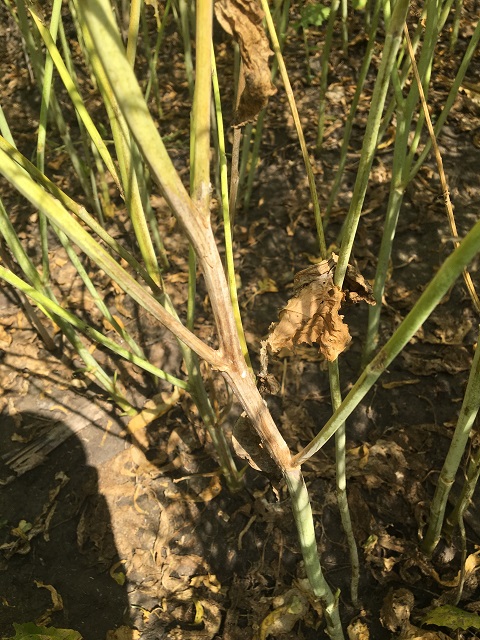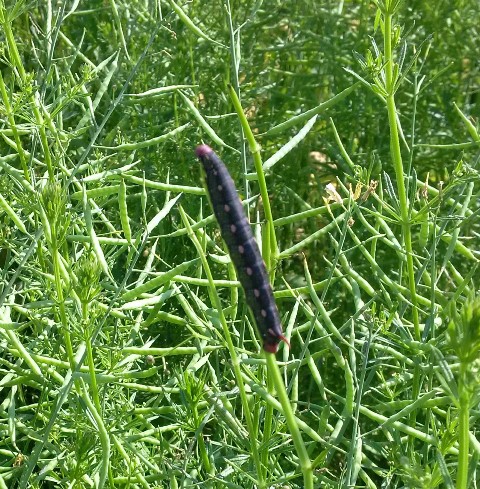Manitoba Insect & Disease Update
Issue 13: August 16, 2017
Summary
Diseases:
Sclerotinia stem rot has been observed in scattered canola fields through the canola disease survey. In most fields levels are low, but incidence was about 50% in a field in the Carman area.
Blackleg symptoms are easiest to identify when stems are cut at the base. The perfect time to scout is at harvest, so bring your clippers along and jump off the swather or combine from time to time.
Insects:
Soybean aphids continue to be a concern in some fields, with insecticide applications having occurred. In some soybean fields natural enemy populations seem to be building in response to the soybean aphids. Management decisions are further complicated in some fields as the soybean move towards the R6 growth stage.
Bertha armyworms: High levels of larvae continue to be reported from some canola fields in western Manitoba.
Sclerotinia Stem Rot in Canola
The canola disease survey is continuing or wrapping up across the province. Levels of blackleg, sclerotinia stem rot, aster yellows, and verticillium wilt have all been observed. Most disease levels are low overall due to the lack of moisture throughout the growing season and timely fungicide applications for diseases like sclerotinia stem rot. Higher levels of sclerotinia stem rot have been observed in canola fields in the Carman area, with one field showing more than 50% incidence of affected plants. The general rule of thumb is that yield loss equals 0.5 x incidence. Therefore, if a field is showing approximately 50% incidence, yield loss could be estimated around 25%. However, this estimate changes depending on the severity of the disease.

Figure 1. Sclerotinia stem rot in canola
Soybean Aphids: Growth stages most susceptible
The R1 (beginning bloom) to R5 (beginning seed) growth stages are the most susceptible to feeding by soybean aphids. Once plants move into the R6 (full seed) stage, soybean aphids will have less of an impact on yield. In the R6 stage, pods contain green seeds that fills the pod cavity at one of the four uppermost nodes on the main stem. Once the seeds are filling the pod cavity full yield potential has occurred, and soybean aphids are no longer an economic threat to the crop. The University of Wisconsin has a good guide to soybean stages and soybean aphids: http://fyi.uwex.edu/fieldcroppathology/files/2010/12/aphid_thresholds.pdf
Aphids on Canola
The aphid that is usually most noticeable in canola is turnip aphid (Lipaphis erysimi).
They often form clusters at the top of the shoots in canola. They feed only on cruciferous plants.
They often form clusters at the top of the shoots in canola. They feed only on cruciferous plants.
Later-planted canola may be more susceptible to heavy populations of this aphid.
Heavy populations of turnip aphid are often localized within a field, and usually cause little damage if infestations occur after pod development.
Heavy populations of turnip aphid are often localized within a field, and usually cause little damage if infestations occur after pod development.
There are no established economic thresholds for turnip aphids in canola in North America.
As a nominal threshold, it has been suggested that control may be justified when at least 10-20% of the stems are infested with a cluster of aphids in flowering to early pod stages.
Note the presence of natural enemies as well as aphids. Populations can also be reduced by heavy rainfall. Dimethoate (Cygon, Lagon) is the only insecticide registered for turnip aphids on canola in Canada and has a preharvest interval of 21 days.
As a nominal threshold, it has been suggested that control may be justified when at least 10-20% of the stems are infested with a cluster of aphids in flowering to early pod stages.
Note the presence of natural enemies as well as aphids. Populations can also be reduced by heavy rainfall. Dimethoate (Cygon, Lagon) is the only insecticide registered for turnip aphids on canola in Canada and has a preharvest interval of 21 days.
Insect Monitoring Programs
Grasshopper Survey: A reminder for those participating in the grasshopper survey, that counts are done during August, when the majority of grasshoppers are in the adult stage.
Agronomists and farmers who would also be interested in estimating grasshopper numbers in the fields they are in and have this information included in the survey are encouraged to see the survey protocol for more details of the survey and where to send data. Estimates of grasshopper levels can be collected during regular farm visits.
Data from the survey, along with weather data during the egg laying period of the grasshoppers, is used to produce a forecast for 2018.
The protocol and data sheet for the grasshopper survey is at: http://www.gov.mb.ca/agriculture/crops/insects/mb-grasshopper-survey.html
Data from the survey, along with weather data during the egg laying period of the grasshoppers, is used to produce a forecast for 2018.
The protocol and data sheet for the grasshopper survey is at: http://www.gov.mb.ca/agriculture/crops/insects/mb-grasshopper-survey.html
Insect Identification Quiz
This caterpillar was found in a canola field that had cleavers. What is this caterpillars?

Photo by Nicole Clouson - Manitoba Agriculture
Answer: This is the Galium sphinx (Hyles gallii), sometimes called the bedstraw hawkmoth.
Bedstraw and Cleavers (Galium aparine) are a couple of its host plants. They will also feed on plants like fireweed and plantain.
Bedstraw and Cleavers (Galium aparine) are a couple of its host plants. They will also feed on plants like fireweed and plantain.
Although they may be found in crops, they will likely do minimal or no feeding on the crops, instead feeding on weeds like cleavers in the field.
This caterpillar is closely related (same genus) to the spurge hawkmoth (Hyles euphorbiae) which has been introduced to control leafy spurge.
----------------------------------------------------------------------------------------------------------------------
Compiled by:
John Gavloski, Entomologist Holly Derksen, Field Crop Pathologist
Manitoba Agriculture Manitoba Agriculture
Phone: (204) 750-0594 Phone: (204) 750-4248
To report observations on insects or plant pathogens that may be of interest or importance to farmers and agronomists in Manitoba, please send messages to the above contacts.
To be placed on an E-mail list so you will be notified immediately when new Manitoba Insect and Disease Updates are posted, please contact John Gavloski at the address or numbers listed above.
